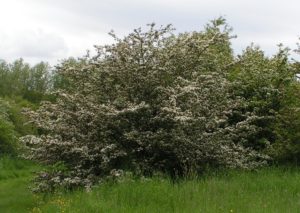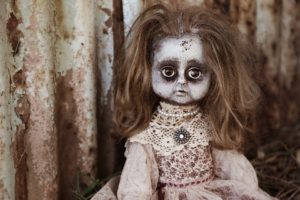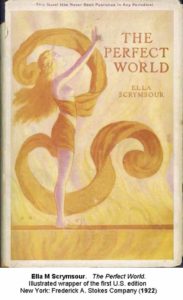“Oh, you modern women! You dabble in science and medicine, you dabble in politics and law, and now you dabble in the occult. What else is there left for mere man?” Today we get lost in Scotland and its folklore with Shiela Crerar, follow a plucky young woman’s psychic endeavours, admit that Flaxman Low, our old occult detective friend, may have met his match, and even trip over William Hope Hodgson.
Were it not for the fact that most of the Scots we know are dangerous and vengeful characters, this would have been entitled Shiela Crerar: The MacHorror. O Best Beloved, we are on the trail of author Ella M Scrymsour, an imaginative writer with a Dickensian name, and her female occult detective from the 1920s…
Vampiric elementals, family curses, clay-corpse dolls, floating eyes, ghosts, ancient clan wars, benevolent servitors and all can be found in the tales of Shiela Crerar, Psychic Investigator. But we should probably introduce the author first. Ella M. Scrymsour (1888-1962) was born in London, daughter of Archibald Robertson, an expatriate Scot. She wrote an odd range of romance, science fiction and ghost stories, including the SF novel The Perfect World: A Romance of Strange People and Strange Places (1922/23).
For a long time time she was a bit of a mystery, though most of her background seems to have been sorted now. Steve Holland, after undertaking some fine detective work of his own, has an excellent stab at the entire matter of Ella M Scrymsour’s background on his Bear Alley site https://bearalley.blogspot.co.uk/2010/09/ella-m-scrymsour-revisited.html
NOT QUITE PERFECT
The Perfect World is not our main interest, but it’s worth raising here because we were fascinated by a further link which reflects on our hero William Hope Hodgson as well. In Ned Brooks’ fanzine It Goes on the Shelf, some years ago, he said:
“In the meantime I have recieved another remarkable book of eldritch sf: The Perfect World by Ella Scrymsour, Nash & Grayson, London (320pp).
“Vince Clarke sent me this moldering tome, which Reginald and Locke both date to 1922. Reginald also lists another by the same author, The Bridge of Distances (1924).
“I mention this book in connection with The Night Land because they are similar in several ways – both are from the same period, both are utterly humorless, and both make use of the idea of dehydrated water (Hodgson’s is a powder that turns to water when the air hits it, while Ms Scrymsour’s is a 1-inch cube of what looks like camphor that makes a quart of water when heated).
The lack of humor makes these books hard to plow through, though The Perfect World is written in conventional English prose and reads far more easily than the obsessively-detailed pseudo-archaic first person narrative of The Night Land. In a way this makes the technical howlers in Ms Scrymsour’s book more startling – her prose is conventional, her very British characters are conventional, and yet, in spite of her bizarre imagination, she apparently had a very dim grasp of physical reality.”
The full article is here:
http://www.fanac.org/fanzines/IGOTS/igotsnew14.htm
Curiously, as this emanates from SF fandom, we must presume that this is the late Vince Clarke we knew from eighties fanzine days.
Not having read The Perfect World, we looked it up at the on-line SF Encyclopedia:
“The Perfect World: A Romance of Strange People and Strange Places (1922), is thought by E F Bleiler almost certainly to consist of two separate magazine novels here published sequentially… In the first main sequence the two young gentlemen protagonists are transported from a company town dominated by their family coalmine into an Underground cave system where an oligarchic Lost Race of dwarf Israelites – exiled after an Old Testament quarrel – has lived for 3000 years and grown horns. After they finally emerge in Australia, after missing World War One, and noting that the End of the World is nigh, they escape in the nick of time with their uncle – who is responsible for the Invention of a suitable space-ready Airship – to Jupiter, where a similar oligarchy, this time pre-Adamic, subjects the main protagonist – as had happened already underground – to erotic inducements. He marries the relevant princess and together they rule Jupiter in peace.”
As you do.
SHIELA CRERAR DOES HER THING
Anyhow, we must go occult. There are few early female protagonists involved in psychic detection, and Shiel Crerar is not only psychic, but a professional investigator. The six stories of her exploits were first published in The Blue Magazine, London: Walbrook & Co., 1920, and consist of:
- The Eyes of Doom
- The Death Vapour
- The Room of Fear
- The Phantom Isle
- The Werewolf of Rannoch
- The Wraith of Fergus McGinty
We learn early in the first of the six stories where we stand. Having had to rent out her Scottish home after the death of her uncle and guardian, Shiela (in her early twenties) goes to London and posts the following blunt notice in the papers:
“Lady of gentle birth, Scottish, young, penniless, possessing strong psychic powers, will devote her services to the solving of uncanny mysteries or the ‘laying of ghosts’. Offer quite genuine. Reply, with particulars and remuneration offered, to S. C. c/o Mrs Barker, 14b Air Street, Regent’s Park, London.”
And her first case drags her back up North:
“If S. C.’s offer is really genuine, will she accept the enclosed £10 on account for immediate expenses, and wire Lady Kildrummie that she is prepared to try to solve, and perhaps lay for ever, the very unpleasant mystery known as the ‘Kildrummie Weird’? If S. C. states the time she will arrive at Arrochar Station, Lady Kildrummie will see that there is a car sent to meet her.”
Scrymsour’s Scotland is confusing. Throughout the stories we are assailed with clan and personal names, locations and histories, and the truth of them is hard to fathom. There is a real village called Arrochar, in the west of Scotland near Loch Lomond, but Kildrummie? We don’t know. Kildrummy Castle, for example, is in Aberdeenshire, rather a way away. Given that Scrymsour is supposed to have spent some time in her youth around Oban, also in the west, there must certainly be reflections of reality in her tales.

In a later tale, set around the Isle of Skye, she describes a puzzling mix of Maclauries and Murdochs.
“ ‘Old Malcolm MacLaurie was mortally wounded at Culloden,’ continued Mrs Murdoch, ‘and his only son, young Malcolm, fled with the Prince to the hills. After a great deal of suffering and privation, they reached the coast in safety, and eventually gained Tath-Gart Isle. A traitor, however, was in their ranks. Wolf Murdoch, Chief of the Clan, left the island secretly, and – for a price – gave information to the English General. He and a boatload of redcoats made their way to the isle, but a faithful gillie gave the alarm, and the Prince and his retinue escaped to Skye.”
It may be that she is drawing on the Clan MacLaurin, but we don’t think there is a Clan Murdoch – it’s a personal name related to sea-faring, and Murdochs were found in a number of clans. The MacLaurins were certainly involved in the rebellion of 1745. The majority of the clan fought for the Pretender Charles Stewart, and members of the family had lands which included the island of Tiree, one of the Inner Hebrides near Skye.
WITCH APPROACH?
What is certain is that Scrymsour draws on Scottish folklore. Not only are some tales concerned with the tradition of a doom which follows each generation, and signs of imminent death in the family, but there are other references to betrayals and consequences. Shiela Crerar is armed with a limited amount of knowledge about ‘witchcraft’ and folkloric magic, though this varies from story to story.
“Shiela pulled a branch of whitethorn – a protection against witchcraft – and held it high above her head.”
You probably know that the whitethorn is also know as hawthorn, amongst other monickers, and the May or Beltane Tree. Thomas the Rhymer, or Thomas of Erceldoune, the Scottish mystic and poet, is said to have met the Fairy Queen by a whitethorn bush.

In another tale, she recognises the use of clay effigies as a long-standing tool of witches. Scrymsour calls them corp chréidh, also known as corp crèadha. They’re similar in some ways to so-called voodoo dolls. The tradition is that when a ‘clay-corpse’ was placed in a stream, it steadily wasted away. A targeted individual in the area would get get sick and deteriorate as the corp crèadha fell apart. Needles could also be used. As recorded elsewhere, on the Tobar and Ualchais site:
“A woman in Vatersay had a notion for a man who rejected her. She created a clay effigy and he suffered ill health until friends discovered the effigy and destroyed it.”
This website contains over 38,000 oral recordings made in Scotland and further afield, from the 1930s onwards.
http://www.tobarandualchais.co.uk/
When not hitting things with whitethorn or driving steel needles into unpleasant remnants, Shiela carries a small pistol, but she relies a lot on the power of traditional Christianity – calling in a priest, keeping to hallowed ground, and occasionally just thinking religious thoughts whilst telling the spirits that God does not approve.
She’s a curious character, a mixture of naivety and pluck – whether you warm to her or not is debatable. The stories are interesting but simplistic in the style of writing, and don’t stand up too well to the passage of time. That she is female and determine to do her own thing is certainly worthy of note, and puts her above a number of other early occult detective contenders.
Miss Shiela Crerar even has a constant suitor, Stavordale Hartland, who worries about her, calls her ‘little girl’ and keeps pressing her to marry him, but she holds him off because she sees herself as having a task to perform, a ‘mission’. Sadly, in the end she does marry him, in a somewhat soppy codicil to the last story – but there is a hint that she will not give up some of her ways, and that he will have to put up with it, so not all is lost.
We couldn’t escape the feeling that some parts of the stories fell into Flaxman Low world. Long-time listeners will remember our amusement at some of these, where the most bizarre things happen, and logic occasionally throws itself out of the window. As with Flaxman Low and Algernon Blackwood’s John Silence, we have the concept of elementals:
“ ‘I believe the place is haunted by an elemental – ‘
“ ‘What is that?’ asked Lady Morven.
“ ‘It is difficult to explain. It is a – something that possesses an existence; it belongs to neither death nor heaven. It draws its life from humanity, or from the astral spirits it may come into contact with.’”
And we have things which are half the sort of ghost/spirit/monster we know, and half something else. The descriptions veer into strange territories, without any apparent humour:
“She was drawn by unseen hands – hands that possessed an unseen body.”
“The eyes grew more venturesome. One night a pair hovered over the dinner table.”

More puzzling is Shiela Crerar’s work ethic in some of the stories. She is a great one for doing, and then waiting, and then doing again. Unlike Flaxman Low, she rarely seems to know what is going on until late in the stories, and relies on a general ‘gift’ or ‘sight’ (which her Uncle also apparently had).
This involves long periods of cluelessness, and some peculiar episodes, such as a terrifyingly haunted place where basically she keeps sleeping in the same room until she has a passing idea. Fairly astonishing, because she does this for about three weeks in total, spending hours in mortal terror and on the edge of a physical heart attack. Given that the assualts of terror only get worse each time, this is especially odd. Her host tells her of the room at the start:
“…It is only an extraordinary coincidence that on the three occasions it has been used as a bedchamber, its occupants have died of heart failure.”
Quite a big coincidence, really – and the solution is one which should have occurred to a passing brickie or carpenter weeks before. She seems inclined to wait for inspiration rather too often. In another story she lets herself be hauled around by vengeful spirits for days until she ‘gets it’, and in one later episode she does something which still puzzles us:
“Shiela gazed in horror as she saw the magician stoop down and lift up in his arms a tiny naked child of perhaps two years. The plump little body squirmed and struggled with fear, but the man held it deftly while he anointed it with oils and sweet-smelling spices. Suddenly he held a knife aloft, and Shiela buried her face in her hands. There was an agonising cry – a cry that ended with a muffled, choking moan – and silence!
“The girl felt too sick to watch; but the scene had its fascination as well as its horror, and tightly clasped in her hand was her loaded revolver. She would make no mistake tonight!”
We’d say it was a major mistake to have a loaded revolver to hand, yet crouch there and watch a man killing a two year old child. Quite what the author was thinking at this point, we can’t imagine.
In conclusion (vaguely): Will you enjoy reading the adventures of Shiela Crerar? Yes, if you make allowances. They are conventional in many ways, but in re-reading them, the importance of her being a young, unmarried woman taking on psychic investigations in 1920 does strike us, and you might even find a sub-text or two to explore in that.
You can read all six tales on-line here:
http://digital.library.upenn.edu/women/scrymsour/crerar/crerar.html
There is also a 2006 Ash Tree Press hardback, Shiela Crerar, Psychic Detective, edited by Jack Adrian, though it’s not cheap.


Just a quick note to say that the Shiela Crerar tales are coupled with The Undying Monster (1922), a novel featuring another early woman occult detective named Luna Bartendale, in one of the volumes in Coachwhip Publication’s series of supernatural detectives. These are easier on the wallet than the Ash Tree hardback.
http://www.coachwhipbooks.com/supernatural-detectives
Thanks. The marvellous thing is that I knew this, downloaded the Coachwhip cover, and then forgot to add it. A new high for greydog!